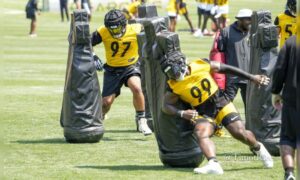By Alex Kozora
The Pittsburgh Steelers’ defensive ends are arguably the team’s biggest question mark heading into 2014. How well will Cam Thomas adjust to playing five tech full time? What can Stephon Tuitt offer the team in his rookie year? Will any of the young pups – Brian Arnfelt, Nick Williams – make an impact? All valid questions.
One player that doesn’t need to be worried about is Cameron Heyward. A budding star in the league, he came into his own in 2013. The team plans to “move” him, though that is a bit of a misnomer considering he played both positions, to right end this year.
The probable idea behind this is to have Thomas, a bigger and stronger defender, man left defensive end, facing the offense’s strong side. But do Heyward’s numbers suggest otherwise?
In a word: yes.
Reviewing our charts from 2013, we can determine the rushing yards allowed by each defensive end. We’ll start with right end, including Heyward and Brett Keisel. Only counting rushing plays towards right end, right tackle, or right guard, here are the numbers.
| NAME | RUSHES | YARDS | YPC |
|---|---|---|---|
| Keisel | 90 | 397 | 4.4 |
| Heyward | 56 | 235 | 4.2 |
As you can see, Heyward’s average is slightly lower than Keisel’s but the difference is fairly negligible.
Now let’s take a look at left end with Heyward and Ziggy Hood. One admission for Heyward is the exclusion of Terrelle Pryor’s 93 yard run that posed a risk of skewing his numbers. It was the only number of the whole study excluded but there’s a strong argument for doing so. That run was not remotely Heyward’s fault. With that in mind, the numbers below.
| NAME | RUSHES | YARDS | YPC |
|---|---|---|---|
| Hood | 104 | 478 | 4.6 |
| Heyward | 33 | 86 | 2.6 |
A staggering difference. Heyward’s average is a full two yards lower than Hood’s. Granted, Heyward’s sample size of 33 plays isn’t ideal statistically speaking, but it’s still representative.
Let’s take it a step further and using Heyward’s numbers, prorate the yards allowed if he picked up each defensive ends snaps for a full season. Meaning, if he hypothetically played Hood’s 90 snaps allowing 2.6 yards per carry instead of Hood’s 4.6.
| POSITION | RUSHES | YARDS | YPC | YD DIF | YD DIF/GM |
|---|---|---|---|---|---|
| LE | 104 | 270 | 2.6 | -208 | -13 |
| RE | 90 | 378 | 4.2 | -19 | -1.2 |
Obviously, the numbers show the same result, Heyward was clearly more successful than Hood while only marginally better than Keisel, but it really hammers home the point.
In this hypothetical, Heyward would have allowed 208 fewer yards in Hood’s 104 snaps. That’s an average of 13 yards per game. Heyward’s improvement only works out to slightly over one yard per game over Keisel.
Is allowing less than 2.55 yards per carry a feasible number for Cam Thomas? It seems unlikely.
Thomas doesn’t have much experience at either side so he can be taught to play either side. John Mitchell noted that Tuitt primarily played right end in college. It only makes sense to place Heyward at left end in 2014.
How many snaps he actually sees there remains to be seen.







